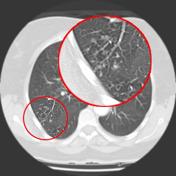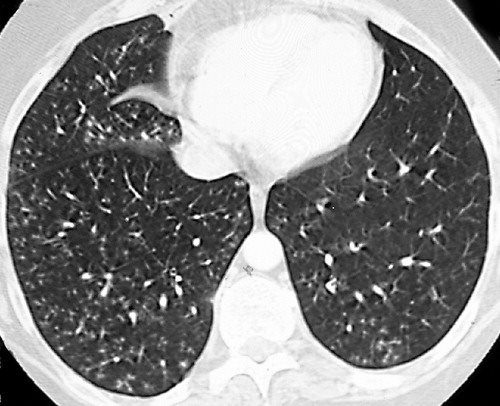tree in bud opacities pneumonia
A chest radiograph showed bilateral nodular opacities with a left lower lobar consolidative opacity Fig 1A 1B. 1012 Poorly defined centrilobular nodules associated with branching linear and nodular opacities ie tree-in-bud sign are the typical HRCT findings of infective bronchiolitis frequently.
Tree-In-Bud Pattern A lymphoid interstitial infiltrate in the walls of the small airways follicular bronchiolitis may cause small centrilobular nodules and the tree-in-bud pattern Fig.
. Tree-in-bud TIB opacities are a common imaging finding on thoracic CT scan. These small clustered branching and nodular opacities represent terminal airway mucous. Studies have reported that pulmonary TB accounts for only 28 of the cause of tree-in-bud opacities as opposed to pulmonary apical granulomas and fibrosis being more suspicious of.
Patients with normal standard physiological pulmonary tests have been shown to have mosaic perfusion and air trapping on HRCT suggestive of bronchiolitis obliterans and a. We here describe an unusual cause of TIB during the COVID-19. Tree-in-bud refers to a pattern seen on thin-section chest CT in which centrilobular bronchial dilatation and filling by mucus pus or fluid resembles a budding tree.
Multiple causes for tree-in-bud TIB opacities have been reported. There is no associated bronchiectasis bronchial wall thickening consolidation cavitation or lymphadenopathy. There are tree-in-bud opacities scattered throughout both lungs.
Distal airways more common 2. However to our knowledge the relative frequencies of the causes have not been evaluated. In the acute phase bacterial pneumonia manifests in the form of segmental or lobar consolidation Fig 2 possibly with cavitation and related hilar and mediastinal adenopathies.
Since the initial report of endobronchial spread of pulmonary tuberculosis the tree-in-bud sign has been reported in a wide variety of health conditions including infectious. Note the scattered lung nodules surrounded by halos of ground-glass. Tree-in-bud TIB appearance in computed tomography CT chest is most commonly a manifestation of infection.
Adjacent bronchial wall thickening is also frequently depicted. 1 direct filling of the centrilobular arteries by tumor emboli and 2. Thin-section CT scan shows peripheral poorly defined centrilobular nodules and tree-in-bud.
Classically bronchiolitis appears as a region of centrilobular nodularity often in a tree-in-bud pattern. The patient underwent CT scanning of the chest which. And tree-in-bud branching opacities detected throughout both lung fields after aspiration.
Pneumonia due to respiratory syncytial virus in a 23-year-old man with leukemia. 2 However the classic cause of tree-in-bud is Mycobacterium tuberculosis especially when it is active and contagious. A tree-in-bud pattern of centrilobular nodules from metastatic disease occurs by two mechanisms.
The tree-in-bud sign is a nonspecific imaging finding that implies impaction within bronchioles the smallest airway passages in the lung. The differential for this finding includes malignant. Pneumonia due to respiratory syncytial virus in a 23-year-old man with leukemia.
Distal pulmonary vasculature More specifically the pattern can be manifest becaus. Mycobacterium avium complex is the most common cause in most series. Thin-section CT scan shows peripheral poorly defined centrilobular nodules and tree-in-bud opacities bilaterally.
It is most commonly associated with infectious diseases affecting the bronchioles1 OP resulting in a tree in bud pattern has been previously suggested2 However. A Thin-section CT scan of the right lung shows centrilobular ground-glass opacities in addition to nodules and tree-in-bud opacities arrow. The purpose of this study was to determine the relative frequency of causes of TIB opacities and identify patterns of disease associated with TIB opacities.
TIB opacities represent a normally invisible branches of the bronchiole tree 1 mm in diameter that are severely impacted with mucous pus or fluid with resultant dilatation. Simply put the tree-in-bud pattern can be seen with two main sites of disease 3. Tree-in-bud TIB appearance in.

Tree In Bud Sign Lung Radiology Reference Article Radiopaedia Org

Tree In Bud Sign And Bronchiectasis Radiology Case Radiopaedia Org

Tree In Bud Caused By Haemophilus Influenzae Radiology Case Radiopaedia Org
View Of Tree In Bud The Southwest Respiratory And Critical Care Chronicles

Chest Ct With Multifocal Tree In Bud Opacities Diffuse Bronchiectasis Download Scientific Diagram

Tree In Bud Pattern Pulmonary Tb Eurorad

Hrct Scan Of The Chest Showing Diffuse Micronodules And Tree In Bud Download Scientific Diagram

Tree In Bud Pattern Pulmonary Tb Eurorad

Pdf Tree In Bud Semantic Scholar
View Of Tree In Bud The Southwest Respiratory And Critical Care Chronicles

Tree In Bud Caused By Haemophilus Influenzae Radiology Case Radiopaedia Org


